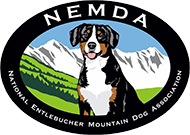Hip and Knee Issues in the Entlebucher
NEMDA BCOE Breeders are required to obtain OFA (Orthopedic Foundation of America) hip evaluations of all breeding stock. Many of our breeders suggest all their offspring obtain OFA evaluations regardless of breeding status. Results of these evaluations help our breeders understand and monitor the prevalence and incidence of Hip Dysplasia in the Entlebucher breed. In the past 20 years of evaluations, OFA reports that statistically, 80% of the Entlebuchers evaluated have received passing evaluations from the OFA.
Here is the advanced search link for OFA Hip Test results.
Hip dysplasia
Hip dysplasia is a deformity of the hip that occurs during growth. The hip joint is a ball and socket joint. During growth, both the ball (the head of the femur, or thighbone) and the socket in the pelvis (acetabulum) must grow at equal rates.
What causes hip dysplasia?
Hip dysplasia is a genetic disease that is affected by factors such as diet, environment, exercise, growth rate, muscle mass, and hormones. As this disease is most commonly seen in large breed dogs (generally greater than 50 lbs or 22 kg), these puppies should be kept at a normal, lean weight during growth, rather than overfed and encouraged to grow “big.”
The early diagnosis of CHD will enable early treatment which helps minimize discomfort and prevent more rapid degeneration of the joint. It will also aid breeders in identifying a dysplastic dog which had been considered as potential breeding stock.
Hip evaluations, which include palpation and hip manipulation should be done on young dogs of 4 to 6 months to help determine the presence of CHD. If a problem is noted, radiographs can be used to confirm the presence of CHD. Early diagnosis increases the number of available treatment options as some surgical procedures can only be performed on pups before arthritic changes develop.
The treatment options available for dysplastic dogs depend on the degree of joint damage, the owners expectations for the dog, and the financial means of the owner. Fortunately, there are treatment options available which are effective in alleviating pain and disability for our canine friend.
Please visit the following webpages for more information about hip dysplasia:
NEMDA BCOE Breeders are required to obtain patellar evaluations of all breeding stock and submit these to OFA. An OFA number will be issued to all dogs found to be normal at 12 months of age or older. The OFA number will contain the age at evaluation and it is recommended that dogs be periodically reexamined as some luxations will not be evident until later in life.
Here is the advanced search link for OFA Patella Test results
Luxating Patella
The patella, or ‘kneecap,’ is normally located in a groove on the end of the femur (thigh bone) just above the stifle (knee). The term luxating means ‘out of place’ or ‘dislocated’. Therefore, a luxating patella is a kneecap that moves out of its normal location. Pet owners may notice a skip in their dog’s step or see their dog run on three legs. Then suddenly they will be back on all four legs as if nothing happened.
Initial evaluation can begin at 6-8 weeks of age, prior to the puppy’s release to the new owner. Owners are encouraged to have their vet continually evaluate their dog’s patellas throughout their life.
Please visit the following webpages for more information about patellar luxation:
Obese dogs and dogs with knee problems such as a luxating patella may be predisposed to rupturing their cruciate ligaments. Entlebuchers are notorious for going all out to catch a ball or toy so it’s important to avoid the “Weekend Warrior” syndrome. Make sure your dog gets routine exercise to strengthen muscles, and discourage activities where he is sent running and then must suddenly change direction.
Cranial Cruciate Ligament Rupture
One of the most common injuries to the knee of dogs is tearing of the cranial cruciate ligament (CCL). This ligament is similar to the anterior cruciate ligament (ACL) in humans. There are actually two cruciate ligaments inside the knee: the cranial cruciate ligament and caudal cruciate ligament. They are called cruciate because they cross over each other inside the middle of the knee. For more information on these ligaments and how they can become damaged, see the (VCA) handout Cruciate Ligament Rupture in Dogs.
When the CCL is torn or injured, the shin bone (tibia) slides forward with respect to the thigh bone (femur), which is known as a positive drawer sign. Most dogs with this injury cannot walk normally and experience pain. The resulting instability damages the cartilage and surrounding bones and leads to osteoarthritis (OA).
Please visit the following webpages for more information about Cranial Cruciate Ligament injury and repair:





